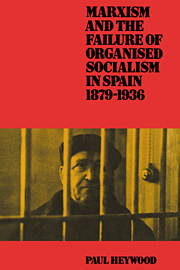Book contents
- Frontmatter
- Contents
- Preface
- Abbreviations used in text
- 1 Decaffeinated Marxists: the PSOE, 1879–1914
- 2 Reform, revolution and the roots of rupture: the PSOE, 1914–1919
- 3 Socialist schism and the development of organised Communism, 1919–1923
- 4 Dealing with a Dictator: organised Socialism, 1923–1931
- 5 Marxist mistakes: misinterpreting the Second Republic, 1931–1934
- 6 Marxism marginalised: the PSOE and the creation of the Popular Front, 1934–1936
- Conclusion
- Notes
- Bibliography
- Index
3 - Socialist schism and the development of organised Communism, 1919–1923
Published online by Cambridge University Press: 08 September 2009
- Frontmatter
- Contents
- Preface
- Abbreviations used in text
- 1 Decaffeinated Marxists: the PSOE, 1879–1914
- 2 Reform, revolution and the roots of rupture: the PSOE, 1914–1919
- 3 Socialist schism and the development of organised Communism, 1919–1923
- 4 Dealing with a Dictator: organised Socialism, 1923–1931
- 5 Marxist mistakes: misinterpreting the Second Republic, 1931–1934
- 6 Marxism marginalised: the PSOE and the creation of the Popular Front, 1934–1936
- Conclusion
- Notes
- Bibliography
- Index
Summary
The aftermath of the First World War brought profound political upheaval throughout Europe. The collapse of three major imperial dynasties, Russian, German and Austro-Hungarian, either during or as a result of the war, heralded the redrawing of the European political map at the 1919 Treaty of Versailles. This treaty saw the dismantling of German territories, and led to the establishment of independent republics in Austria, Hungary, Czechoslovakia, Poland and Yugoslavia, as well as of the Weimar regime in Germany. Of equal political significance was the 1917 Bolshevik Revolution. Lenin's triumph served as a stirring stimulus to revolutionary Socialists throughout Europe. Indeed, up until the 1924 Locarno Pact, which ushered in a lustrum of relative peace, revolutionary winds swept westwards from Moscow, whipped up by the events of October 1917. The Bolshevik success did not, of course, exercise a direct causal impact upon all the dramatic transformations which occurred in Europe in its wake. Nonetheless, the establishment of Communist rule in Russia served as the axis of an ideological division which has remained deep-rooted ever since. In many ways, this division was at its most stark in the post-war years. Thus, if Communism as cause lay behind the Spartakus uprising of January 1919 in Germany and Gramsci's Turin-based Factory Council movement in Italy the following year, Communism as curse served equally as a powerful rationale behind the rise of fascism in Europe in the 1920s and 1930s.
In Spain, also, despite non-participation in the war, the struggle between revolutionary and reactionary forces intensified.
- Type
- Chapter
- Information
- Publisher: Cambridge University PressPrint publication year: 1990



